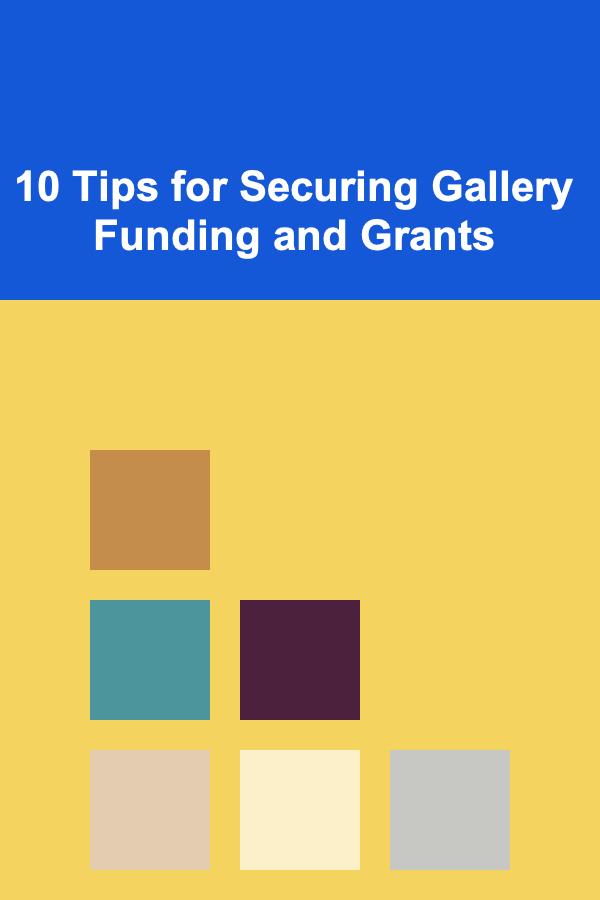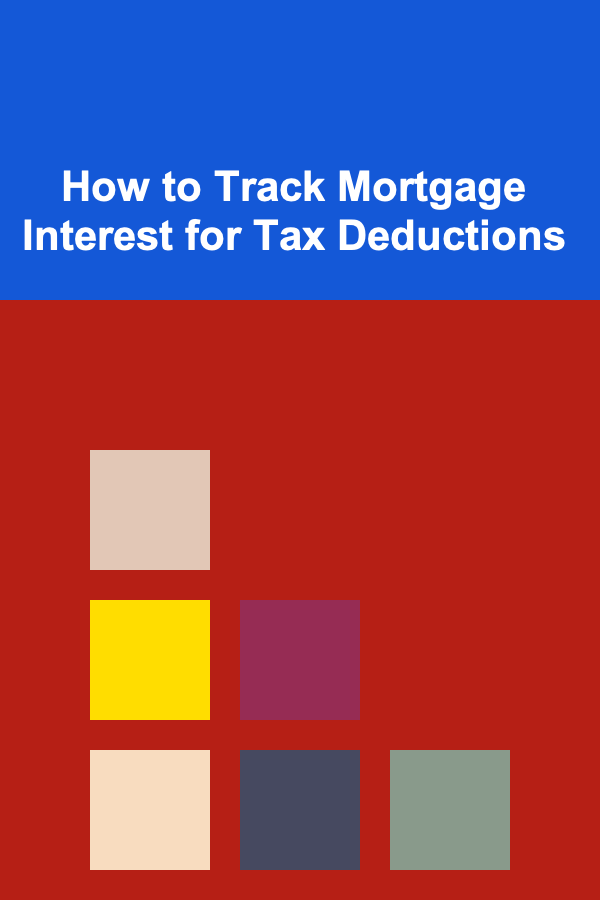
10 Tips for Securing Gallery Funding and Grants
ebook include PDF & Audio bundle (Micro Guide)
$12.99$6.99
Limited Time Offer! Order within the next:

Securing funding and grants is one of the most crucial steps for emerging artists, curators, or gallery owners looking to sustain and grow their projects. Whether you're looking to host a new exhibition, develop an artist residency, or enhance the infrastructure of your gallery, grants and funding provide the financial backbone to make these dreams a reality. However, the process of applying for and securing these resources can be complex and competitive. This article outlines ten tips that can help artists, curators, and gallery owners navigate the world of grants and funding and increase their chances of success.
Understand the Funding Landscape
The first step in securing gallery funding and grants is to have a comprehensive understanding of the available funding opportunities. These can come from various sources, including government agencies, private foundations, corporations, and non-profit organizations. Some grants are specific to certain types of projects (e.g., exhibition-related), while others might be more general (e.g., operational costs or capital improvements). Knowing which funding options best align with your project is crucial for saving time and effort in the application process.
Key Actions:
- Research local, national, and international funding bodies that support the arts.
- Stay informed about opportunities by subscribing to newsletters and databases like Artforum, The Art Newspaper, or GrantWatch.
- Keep track of deadlines and eligibility criteria for each funding source.
Craft a Clear and Compelling Project Proposal
When applying for funding or grants, your proposal is the most important document in the process. A well-crafted proposal demonstrates the value of your project, outlines its objectives, and shows how the funding will be used. The clarity and professionalism of your proposal often determine whether you are considered for funding.
Key Elements of a Strong Proposal:
- Project Overview: A succinct description of the project, including objectives, scope, and target audience.
- Artistic or Cultural Value: Articulate how the project will contribute to the art world or community. Why is it important?
- Budget Breakdown: Clearly outline how the requested funds will be used (e.g., materials, artists' fees, exhibition setup costs).
- Timeline: A detailed timeline that shows project milestones and completion dates.
- Outcome Measurement: Define how success will be measured and what impact the project aims to achieve.
Remember, the more specific you are about your project's goals and needs, the more compelling your proposal will be to potential funders.
Tailor Your Application to the Funder's Priorities
Every funder has its unique priorities, guidelines, and funding focus areas. It's important to tailor your proposal to align with the funder's goals. If a grant program supports innovative, experimental art projects, emphasize the originality and creativity of your work. If it's aimed at community-based projects, highlight how your project will engage local audiences or contribute to social change.
Key Actions:
- Read through the funder's mission statement and past grant recipients.
- Make sure your project fits within the funder's stated objectives.
- Use language and references that resonate with the funder's values.
Tailoring your application not only increases your chances of success but also shows that you respect the funder's priorities and are a good match for their funding goals.
Demonstrate Your Artistic or Organizational Capacity
Funders want to know that you and your team have the experience and ability to execute the proposed project. They need assurance that you have a track record of delivering successful projects, and that your gallery or artistic practice is sustainable. This is particularly important for first-time applicants or emerging artists.
Key Actions:
- Highlight past exhibitions, programs, or relevant projects you have worked on.
- Include testimonials from past collaborators, artists, or patrons who can vouch for your ability to deliver.
- If applicable, include any awards, press mentions, or recognitions that showcase your credibility.
This helps build trust and credibility with potential funders.
Develop a Strong Network of Partners and Collaborators
Collaboration is often seen as a strength in grant applications. If you can bring together a network of partners---whether other galleries, artists, curators, or institutions---it increases the likelihood of your project being funded. Funders are more likely to support initiatives that demonstrate broad community engagement and collaboration.
Key Actions:
- Form partnerships with other galleries, local organizations, artists, or institutions who can enhance the scope of your project.
- Leverage these collaborations to show that your project will have a far-reaching impact beyond your gallery or artistic practice.
- Include letters of support or partnership agreements with your application.
A strong network demonstrates that your project is well-connected and has broader support, which makes it more attractive to funders.
Prepare a Realistic and Detailed Budget
The budget is a key element of any funding application, as it shows the funder how their money will be spent. A poorly planned or unrealistic budget can be a major red flag, so it's essential to be as precise and transparent as possible in your financial plan.
Key Budgeting Tips:
- Be detailed: Break down costs clearly, including artists' fees, materials, transportation, venue costs, insurance, marketing, etc.
- Include contingency funds: Consider a small contingency for unexpected costs (usually 5-10% of the total budget).
- Justify all expenses: Make sure that every expense in the budget has a clear rationale and is directly related to the project's objectives.
- Show other funding sources: If your project is supported by multiple funders, show the full picture of your financial backing.
A detailed and realistic budget demonstrates financial responsibility and helps funders trust that their investment will be managed effectively.
Demonstrate Long-Term Impact and Sustainability
While it's important to secure immediate funding for your project, funders are often interested in how the project will have a lasting impact. Show them how your gallery or project can continue to thrive beyond the immediate project timeframe.
Key Actions:
- Include plans for audience engagement, follow-up exhibitions, or programs that will keep your gallery relevant.
- Describe how your project fits into your long-term goals as an artist or gallery owner.
- Demonstrate how your project might open doors for future funding or sustainable income streams (e.g., ticket sales, private donations, or earned income).
Showing that you're thinking about long-term sustainability can make your project more appealing and demonstrates that you're committed to its success in the long run.
Be Transparent and Honest
While you want to present your project in the best possible light, it's equally important to be transparent and honest in your grant applications. If your project faces challenges, explain how you plan to address them. If there are risks involved, discuss how you plan to mitigate them. Funders appreciate honesty, as it shows that you are aware of your project's potential issues and have thought them through.
Key Actions:
- Acknowledge potential challenges or risks, and outline how you will address them.
- Be transparent about your gallery's financial status or other aspects of the project.
- Avoid exaggerating claims or overpromising results.
Transparency builds trust and credibility, which can improve your relationship with funders in the long run.
Leverage Technology to Streamline the Application Process
Many funding organizations have an online application process, which can be more convenient but may also be more competitive. Using digital tools to streamline your application, keep track of deadlines, and ensure that all necessary documents are prepared can give you an edge over other applicants.
Key Actions:
- Use project management tools to organize your grant applications and deadlines (e.g., Trello, Asana).
- Create digital portfolios, websites, or video proposals to present your project in an engaging format.
- Ensure your application is submitted in the required format and before the deadline.
Harnessing technology can help ensure a smoother, more professional application process.
Follow Up and Build Relationships
After submitting your application, it's essential to follow up with the funder. A polite, professional follow-up can show your commitment to the project and foster a relationship with the funder for future opportunities. Even if your application is not successful, maintaining a relationship can lead to opportunities down the line.
Key Actions:
- Send a thank-you email after submitting your application, expressing gratitude for the opportunity.
- If your application is rejected, ask for feedback to improve future applications.
- Stay in touch with funders and keep them updated on your progress, which can help secure future funding.
Building lasting relationships with funders can open up more opportunities in the future.
Conclusion
Securing gallery funding and grants can be a daunting process, but with careful planning, clear proposals, and a well-thought-out strategy, you can significantly improve your chances of success. By understanding the funding landscape, tailoring your application to funders' priorities, building a strong network, and preparing realistic budgets, you can pave the way for successful funding opportunities that will help bring your artistic vision to life. The key is persistence, professionalism, and continual learning from each application process, whether you secure funding or not.
Reading More From Our Other Websites
- [Organization Tip 101] How to Simplify Your Fitness Routine for Better Results
- [Home Party Planning 101] How to Choose the Right Party Games for Your Home Celebration
- [Home Staging 101] How to Stage Your Home for Families with Kids
- [Needle Felting Tip 101] Best Ways to Incorporate LED Lights into Needle‑Felted Art Pieces
- [Skydiving Tip 101] Step-by-Step Guide to a Safe Tandem Skydiving Experience
- [Home Budget 101] How to Save on Home Decor Without Compromising Style
- [Organization Tip 101] How to Create a Relaxation Space That's Tidy and Inviting
- [Personal Financial Planning 101] How to Use the 50/30/20 Rule to Optimize Your Spending
- [Home Renovating 101] How to Install a Backsplash in Your Kitchen
- [Home Staging 101] How to Stage Your Home to Appeal to Millennial Buyers

How To Learn to Play Popular Songs on Piano
Read More
How to Become a Confident and Captivating Speaker
Read More
How to Handle Ambiguous Requirements as a QA Analyst
Read More
How to Determine if Your Child Qualifies for the Child Tax Credit
Read More
How to Track Mortgage Interest for Tax Deductions
Read More
10 Tips for Singing with Vibrato Control
Read MoreOther Products

How To Learn to Play Popular Songs on Piano
Read More
How to Become a Confident and Captivating Speaker
Read More
How to Handle Ambiguous Requirements as a QA Analyst
Read More
How to Determine if Your Child Qualifies for the Child Tax Credit
Read More
How to Track Mortgage Interest for Tax Deductions
Read More